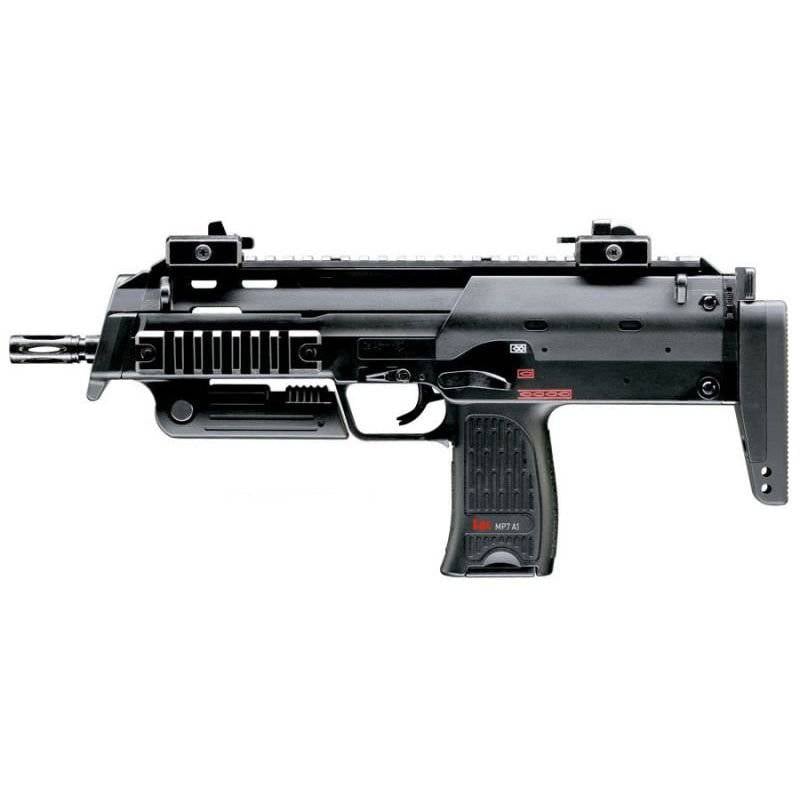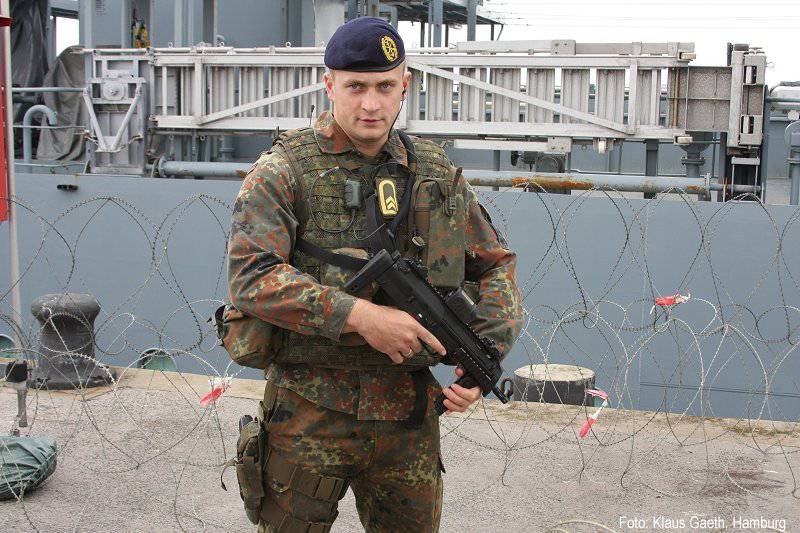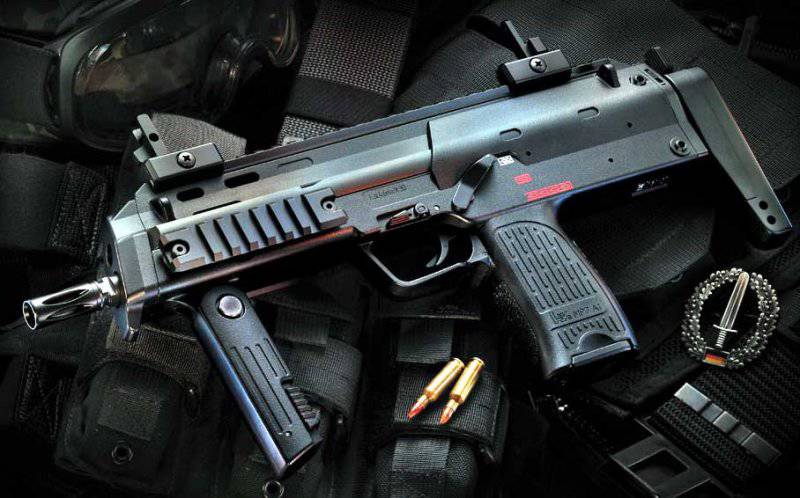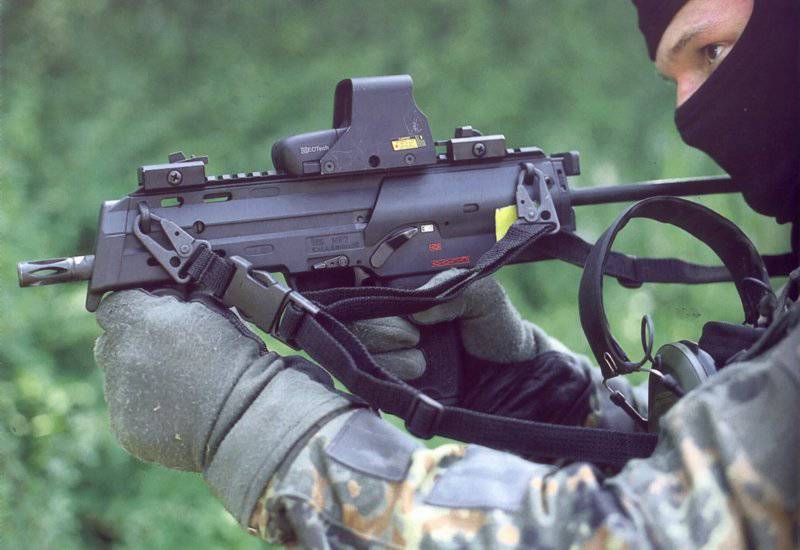Maschinenpistole-Sieben from Heckler-Koch
At the beginning of the last decade of the last century, Heckler & Koch specialists decided to expand the range of products and this time to occupy the so-called niche. PDW. Personal Defense Weapon concept (personal weapon self-defense), becoming more widespread, involves the creation of relatively compact types of weapons with sufficient combat performance. PDW is considered as the standard armament of servicemen who, by the nature of service, are not entitled to a “full-sized” machine gun, i.e. armored vehicle crews, gun crews, pilots, staff workers, etc.
After several years of research, HK finally came to the conclusion what their version of this very PDW should be: a small-sized submachine gun (up to the possibility of carrying it in a holster like a pistol), with the corresponding cartridge and good accuracy and accuracy.
Since it was necessary to create a weapon with small dimensions, without sacrificing the fighting qualities, first of all, the capacity of the store, it was decided to make a new submachine gun with the cartridge under it. In cooperation with the English company Radway Green “Heckler-Koch”, they eventually launched into a series the cartridge 4,6x30 mm HK. Interestingly, the German-English cooperation in the creation of a new cartridge went the same way as the Soviet TsNIITochmash back in the beginning of the 70. Recall, then was developed cartridge 5,45х18 mm MPTs for small pistols. In the case of GPMs, the developers “inserted” a new bullet of a smaller caliber into the cartridge case of the 9x18 mm PM cartridge, which ultimately reduced the size and weight of the cartridge, but retained more or less tolerable fighting qualities, although the stopping effect, unlike the breakdown, turned out to be relatively small The Germans, with the British, in turn, did not begin to take the finished cartridge case, but designed it along with the bullet.
Initially, two variants of the 4,6-mm cartridge were created: the armor-piercing 4.6 AP (aka CPSS) and the expansive 4.6 Action (another designation - SHP). Other things being the same, they have a bullet weighing 1,6 grams with a carbide core and an expansive bullet weighing 2 grams, respectively. The first type of patron was supposed to be used in army and police special forces, the second - because of the greater stopping power only in the police. According to the manufacturer, the armor-piercing version of the 4,6x30 mm chuck at distances up to 150 meters breaks through two dozen layers of Kevlar and a 1.5 mm titanium plate into the bargain. Later versions of the cartridge with a conventional shell bullet (2,6 g) and easily destructible training (1,94 g) were created. Moreover, all variants of bullets have a blunt nose - to reduce the likelihood of bounce.
The relatively small size of the cartridge ultimately made it possible to reduce the dimensions of the entire weapon, mainly its thickness. The new weapon received a rather “original” and obvious index - PDW. It can be said that burghers from HK didn’t simply dwell on the name at first. Something similar happened with most of the filling of the submachine gun. As you know, the previous MP5 submachine gun was made on the basis of the G3 automatic rifle. So, with PDW, they decided not to subtilize it, but to do it using the mechanisms of the new G36 machine. The result of the "unification" was a relatively short development time - the first PDW prototype went to the shooting range already in 1999 year.
In general, it looked the same as the subsequent serial variants, with the difference that the prototypes had a smooth coating of the pistol grip and a short Picatinny rail on the receiver. Telescopic butt and folding front handle were already on the prototypes. Thanks to the small-sized ammunition, the regular magazine on 20 cartridges fits completely into the pistol grip, and later the stores on the 30 and 40 cartridges will be presented. They uncritically increase the size of the weapon, although they extend beyond the limits of the handle.
In 2001, the modified submachine gun was called MP7 (MaschinenPistole-7 - Submachine Gun-7), went into series and entered into service with special forces. The PDW “Seven” differs from prototypes with coated handles, which do not give the hand an arrow to slide off of them, Picatinny's strap almost the entire length of the receiver and an updated sight. The latter is open, has adjustable rear sight and front sight. Interestingly, on MP7, standard sights were made foldable — to facilitate the “interaction” of the weapon with the holster. In the folded position, the front sight and rear sight are blocked by special buttons.
Almost immediately after it entered into service, MP7 was able to make war in Afghanistan, and the special forces who used it quickly presented their wishes to HK. As a result, a new version of the submachine gun, MP2003A7, was launched from 1 onwards. The standard modification of the A1 was reduced, and the shape of the pistol grip was slightly modified, for better convenience. Also, for several reasons, the weapon had to be slightly lengthened, but this was offset by a decrease in the butt length. The latter, at the request of the special forces, received a blocker fixing it in one of three positions. In addition to the above, the trigger design was changed for the first time - an automatic safety device was placed on it, similar to those used on Glock pistols.

MP7A1 was so successful that in 2006, it was adopted by all the power structures of Germany, and from 2005, it began to be exported. Interestingly, the MP7SF version, which differs from other MP7 versions in the absence of automatic fire, was created especially for the English police. Why exactly this option was needed by the English "Bobby" - is unknown, and in general such a modification looks dubious.
At the moment, HK MP7 is the main and only possible competitor of the Belgian submachine gun FN P90. If the NATO command intends to replace the 9x19 mm Parabellum cartridge and the weapon for it with a new model, then MP7 and P90 together with their cartridges will have to compete for the right to replace the good old "Couple." And the result of this competition is difficult to predict: “Heckler-Koch” is cheaper, more compact and easier, and P90 is part of a complex, in which besides it and the cartridge there is an FN Five-seveN pistol. At the same time, P90 is older and has already managed to “spread” in considerable quantity.
As already mentioned, most of the details of the MP7 are borrowed from the G36 rifle. Therefore, this submachine gun is one of the few representatives of its class, whose automation works due to powder gases. The piston stroke is short, and the barrel is locked by turning the bolt. Cocking the MP7 resembles a similar process for the M-16 rifle: the shooter pulls back the T-handle located on the back of the receiver, above the butt.
The body is mainly made of plastic, although there are a number of metal parts - mainly pins and seats for internal parts. The trigger mechanism allows you to fire single shots and bursts. Flags of the translator of fire are located on both sides of the receiver above the pistol grip. At the same time, the translator performs the functions of an automatic fuse. The labels indicating the position of the translator-fuse on MP7 are not alphabetic (S, E, F), but pictographic: a white rectangle with a crossed bullet for the “fuse” position, a red bullet in the rectangle for a single lamp and several red bullets for an automatic one.

The layout of the "exterior" MP7 was made in such a way that both right-handed and left-handed could use a submachine gun. You can shoot MP7 with the butt laid out, propped on the shoulder or the elbow (the second option is less convenient), using the front handle, as well as a “pistol-like” one. With proper training, the shooter can even fire with two hands. Cinematographers will probably like this.
There was a fly in the ointment called HK MP7 without a fly in the ointment: some arrows indicate that the original version of the stock was more or less convenient in length, but after upgrading to version A1 it became more difficult and uncomfortable to use the stock. Also, users of the submachine gun faced the same problem that the Soviet security forces went back to the 70s: the weak stopping effect of a small-caliber bullet. Of course, a special expansive bullet can be used in MP7, but if the enemy is wearing a bulletproof vest, there is little use for it. True, there are rumors that German commandos almost immediately, in Afghanistan, figured out how to deal with this scourge: to load armor-piercing and expansive cartridges in turn, just like in aviation during the Second World War.
Sometimes Heckler & Koch MP7 is called the weapon of the future. Well, there is some truth in this title. Plastic body, compatibility with the "body kit", several cartridge options, as they say, for all occasions - it seems that the MP7 has collected almost all the trends in the development of modern small arms. This means that the MP7 in the near future may become a new legend, like the "old man" MP5.


Information